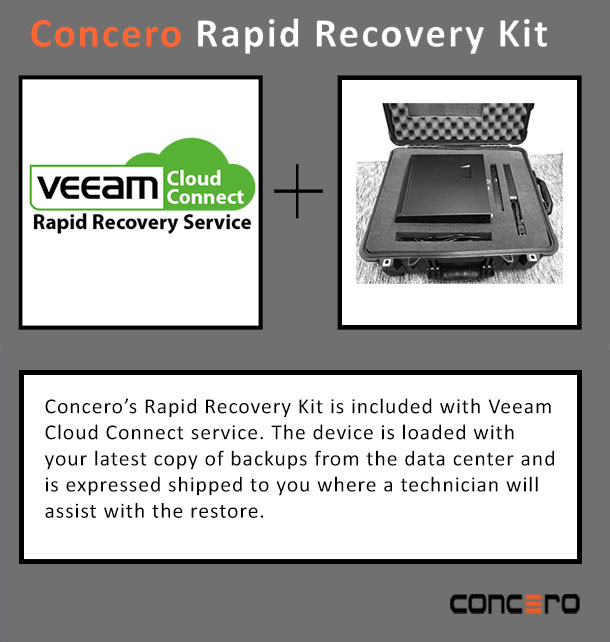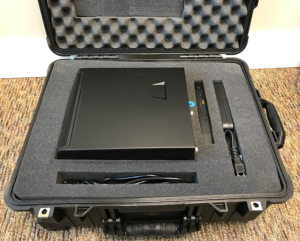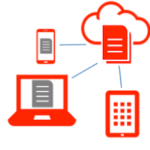Concero’s Rapid Recovery Kit is included with Veeam Cloud Connect service and shipped to you in the event of a disaster.
As a last resort against a disaster, having a copy of your business systems and data at a secure offsite location can make or break a business. By far, the easiest and cheapest way to add offsite backups is through the cloud.
With popular backup solutions like Veeam Cloud Connect it is simple to add your favorite cloud services provider and start replicating your local backups to their data center. But as a disaster recovery solution it is not always that simple or effective.

If you have multiple TBs of data to backup then you will likely have to take the extra step of “seeding” your cloud backup by sending your cloud service provider a copy of your latest backups on a portable storage device.
This seed is necessary because, when combined with the rate of change on new backups, the relatively slow speed of large data transfers over the Internet can make it impossible for the backup system to ever fully synchronize your local backups with the your cloud backups.
For many small organizations their total backup size is less than the capacity of a typical portable storage device so creating and sending off a seed to their cloud provider is not usually a problem. However, things get trickier as the amount of data grows beyond a few TBs.
If you can’t get your backups on a single hard drive then you will need a much more expensive and cumbersome NAS storage device that you can use to safely ship your backup seed to your cloud provider. If this is the case, talk to your cloud backup provider to see how they can assist.
The Recovery Problem
More significantly, the problem of large data transfers over the Internet works both ways. After a disaster, when when your organization needs them most, your cloud backups will be in your service provider’s data center and your only access to them will be over the Internet. At best, it will take days to restore a multi-TB backup over the Internet. For example: a 1 TB file transfer over a reasonably quick 50 Mbps Internet connection will take 2 days, 3 hours, 15 min and 49 seconds according to the File Transfer time Calculator at https://techinternets.com/copy_calc. If there is a transfer issue during this period, you could end up starting all over again.
Few organizations are satisfied with recovery times measured in weeks if they need to restore 4+ TB of backups. So what are the options? You could establish a high speed WAN-connection to your cloud service provider to reduce transfer times but this can take 30+ days to provision and costs $1000+ a month to maintain.
A second approach is to ask your cloud backup provider if they offer a rapid recovery service. This type of service allows you to restore your systems at LAN speeds via a portable storage device loaded with the latest copy of your remote backups from the data center. Once loaded, the portable storage device is then express shipped to your location or even hand delivered the next day by technician who will assist with the restore.
Of course, for those with larger budgets, there are disaster recovery solutions to meet more aggressive recovery time and recovery point objectives. But for many organizations, cloud backups with a rapid recovery service is a reasonable and affordable disaster recovery solution.
Concero Rapid Recovery Kit for Veeam Cloud Connect
 Below is a picture of the “Rapid Recovery Kit” that Concero uses to move multiple-TB of backup files from the data center to the customer’s location for an emergency restore.
Below is a picture of the “Rapid Recovery Kit” that Concero uses to move multiple-TB of backup files from the data center to the customer’s location for an emergency restore.
- Included with Veeam Cloud Connect Backup Service
- Hand Delivered by Technician
- Capacity for up 10 10TB of Veeam Backups
- Connect to your LAN via 1 to 10 Gbps ports
- Rugged and Secure Travel Case for Data
Learn more about Veeam Cloud Connect with Rapid Recovery









Leave A Comment